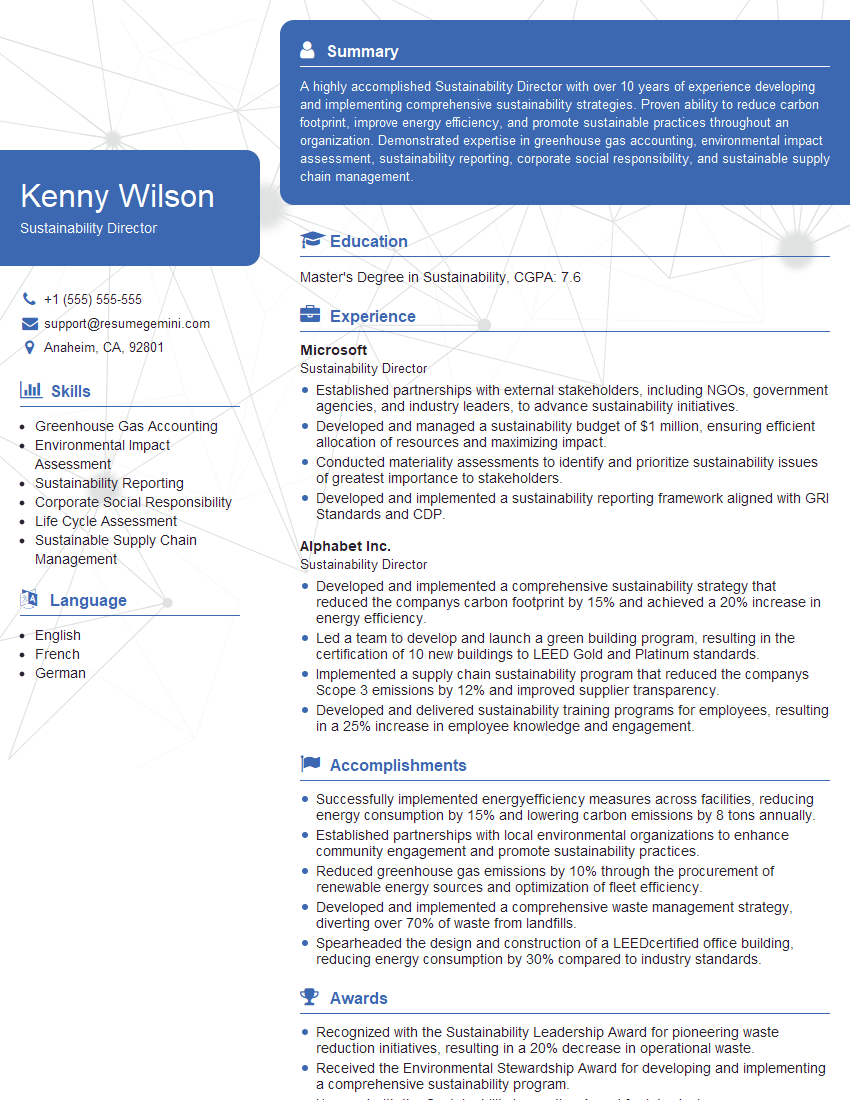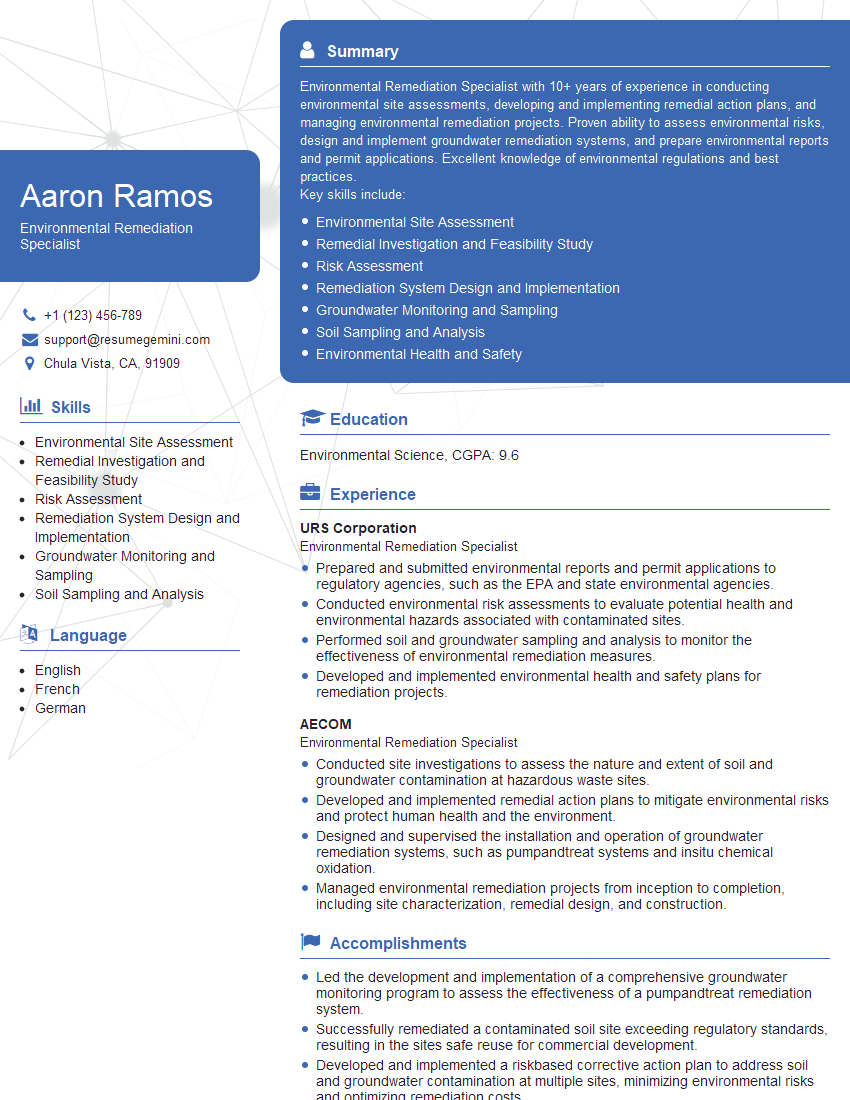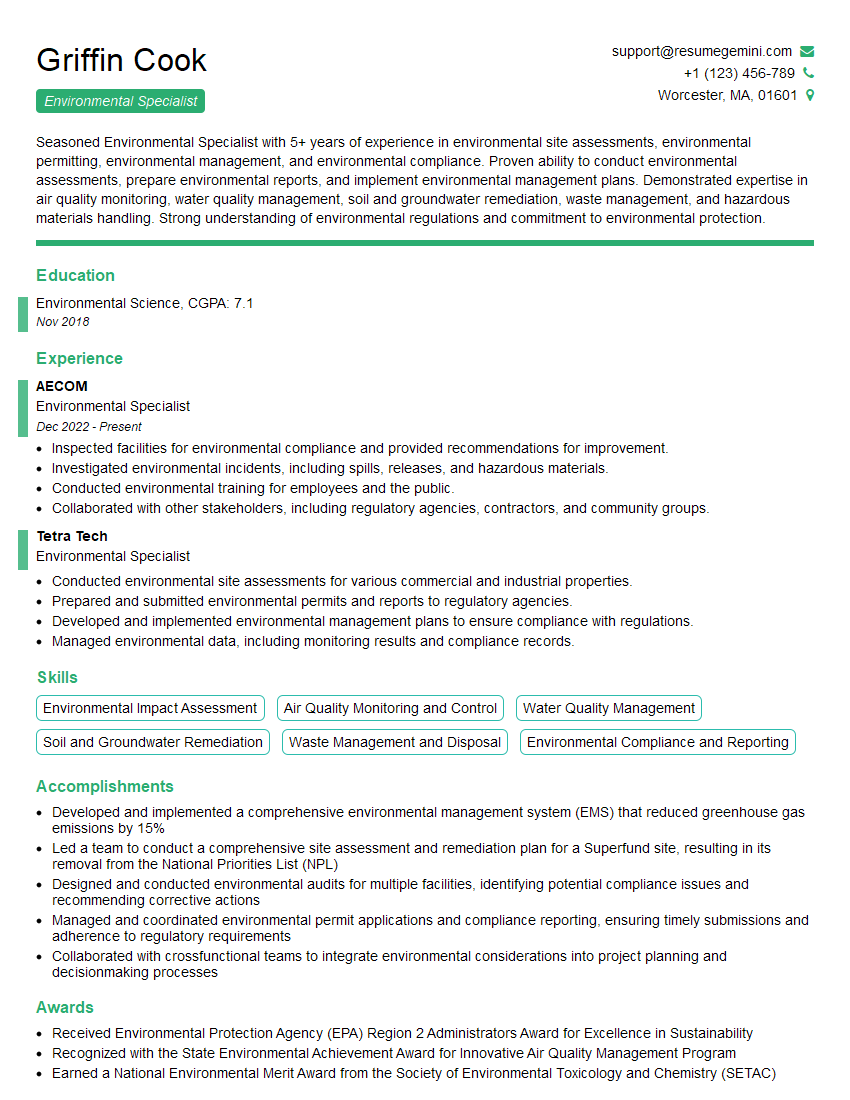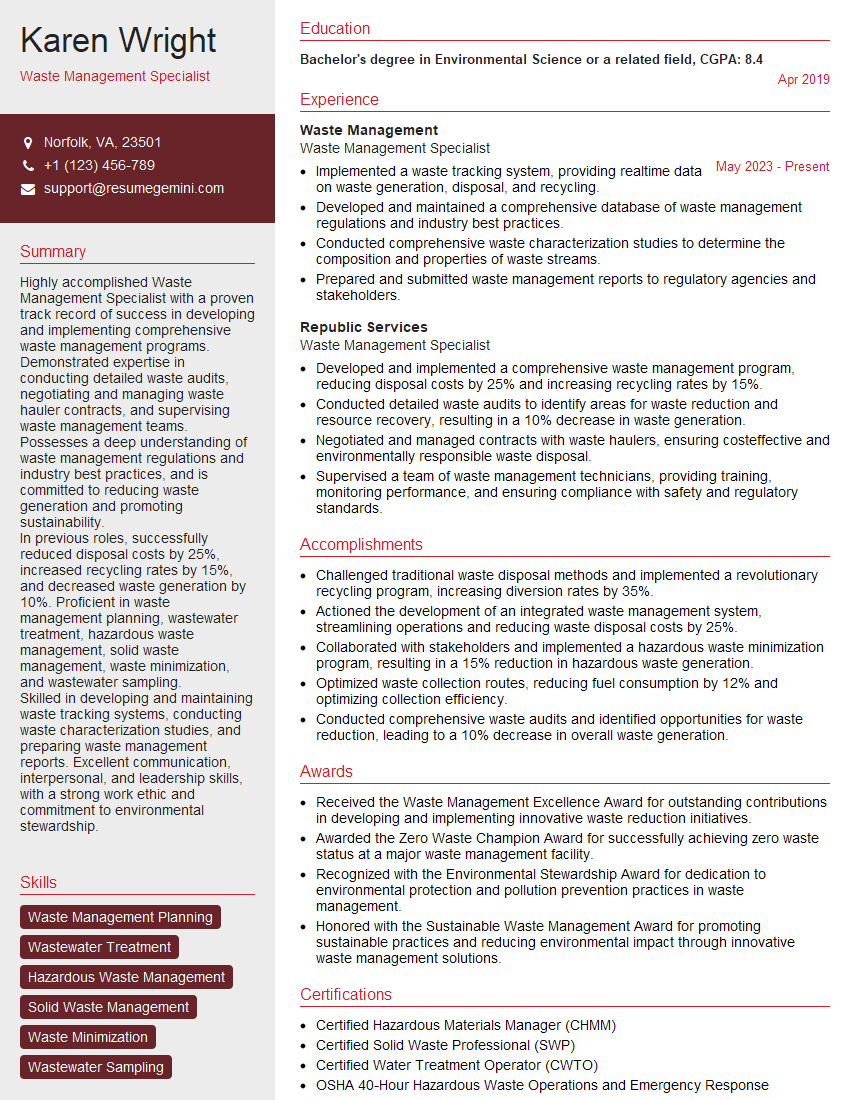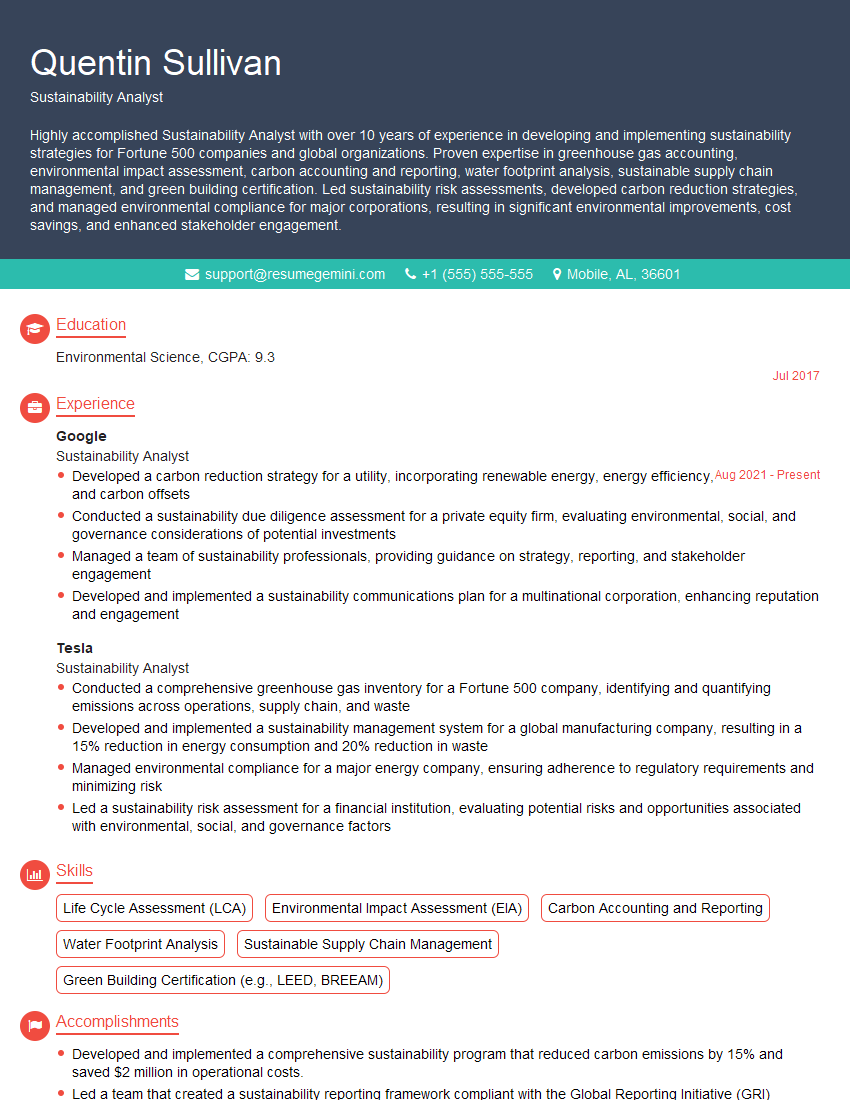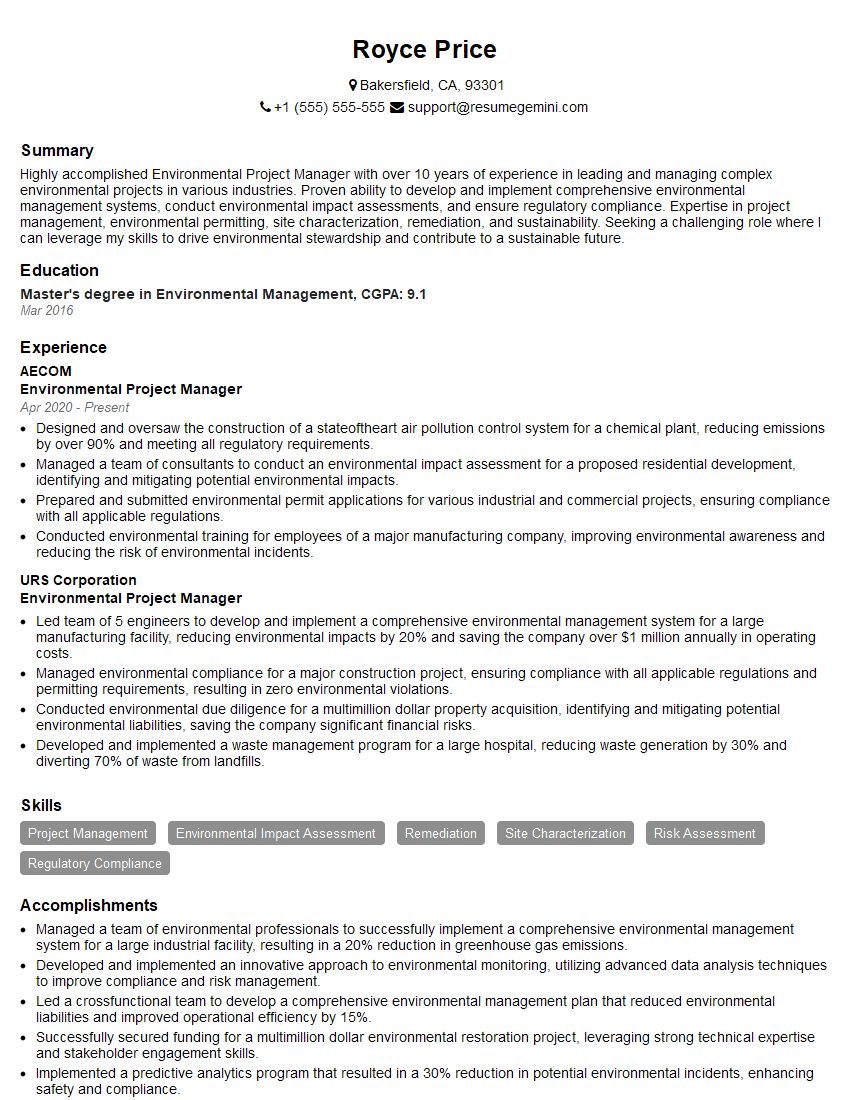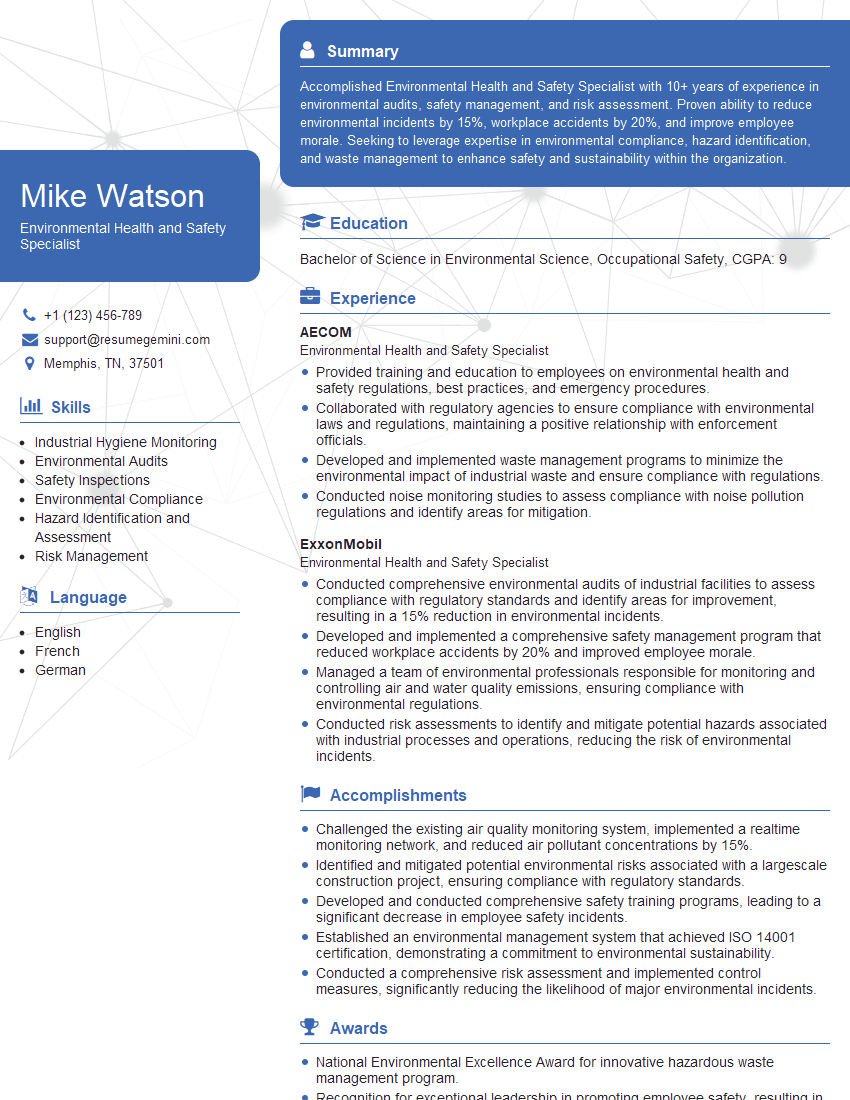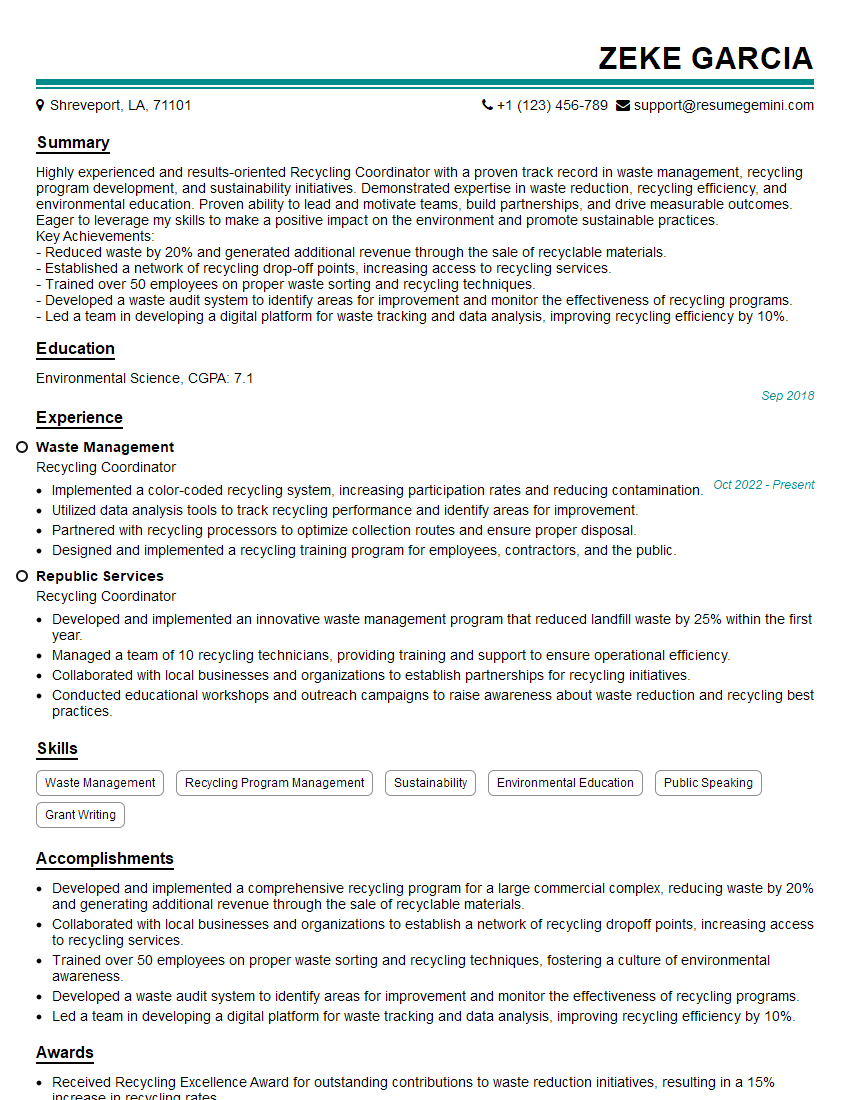Interviews are more than just a Q&A session—they’re a chance to prove your worth. This blog dives into essential Understanding of environmental compliance and recycling interview questions and expert tips to help you align your answers with what hiring managers are looking for. Start preparing to shine!
Questions Asked in Understanding of environmental compliance and recycling Interview
Q 1. Explain your understanding of the Resource Conservation and Recovery Act (RCRA).
The Resource Conservation and Recovery Act (RCRA) is the primary federal law in the United States governing the disposal of solid and hazardous waste. It’s essentially a cradle-to-grave system, regulating the generation, transportation, treatment, storage, and disposal of hazardous waste. Think of it as a comprehensive set of rules ensuring hazardous materials don’t end up polluting our environment.
RCRA establishes a framework for managing hazardous waste through permits, tracking systems, and stringent regulations. For example, facilities that generate, handle, or dispose of hazardous waste need permits demonstrating compliance with specific operational standards. These standards often include things like secure storage, proper labeling, and contingency plans for spills or emergencies. The act also defines what constitutes hazardous waste, categorizing it based on its characteristics (e.g., ignitability, corrosivity, reactivity, toxicity).
A key component of RCRA is its focus on waste minimization and recycling. The act encourages businesses to reduce the amount of hazardous waste they generate in the first place, and it promotes recycling and resource recovery wherever possible. Failure to comply with RCRA can result in significant penalties, including fines and even criminal prosecution.
Q 2. Describe your experience with ISO 14001 environmental management systems.
I have extensive experience with ISO 14001, the internationally recognized standard for environmental management systems. I’ve been involved in the implementation and maintenance of ISO 14001 in several organizations across various industries. This includes conducting internal audits, developing environmental policies, and assisting with certification audits.
My experience encompasses all stages of the process – from initial gap analysis and policy development to implementation of procedures and ongoing monitoring. For instance, in a previous role, I helped a manufacturing company integrate ISO 14001 into their existing operations. This involved identifying key environmental aspects, setting environmental objectives and targets, and implementing control measures to reduce waste and emissions. We ultimately achieved certification and demonstrated a significant reduction in our environmental footprint. I’m familiar with the Plan-Do-Check-Act (PDCA) cycle central to ISO 14001 and adept at using it to continually improve environmental performance.
Q 3. How familiar are you with different waste stream classifications?
My familiarity with waste stream classifications is comprehensive. Waste streams are categorized in numerous ways, depending on the context (municipal, industrial, hazardous, etc.). Broadly, we see categories like:
- Municipal Solid Waste (MSW): This includes everyday trash from homes and businesses – paper, plastics, food scraps, yard waste.
- Industrial Waste: Waste generated from manufacturing processes, often including hazardous components like chemicals or heavy metals.
- Hazardous Waste: Waste that poses a substantial or potential hazard to human health or the environment – toxic, ignitable, corrosive, or reactive materials.
- Recyclable Materials: Materials that can be processed and used to create new products (e.g., paper, plastics, metals, glass).
- Compostable Materials: Organic materials that can be broken down naturally through biological processes.
Understanding these classifications is crucial for proper waste management, ensuring materials are handled and disposed of according to regulations and best practices. Misclassifying waste can have serious environmental and legal repercussions.
Q 4. What are the key differences between recycling and composting?
Recycling and composting are both crucial for waste reduction, but they differ significantly in their processes and outcomes. Recycling transforms waste materials into new products, while composting uses natural decomposition to create soil amendment.
- Recycling: This involves collecting, sorting, and processing materials like paper, plastic, glass, and metal. These materials are then used to manufacture new products, reducing the demand for virgin resources and minimizing landfill waste. Think of it as giving materials a ‘second life’.
- Composting: This is a biological process where organic waste (food scraps, yard waste) is decomposed by microorganisms. The resulting material, compost, is a nutrient-rich soil amendment that improves soil health and reduces the need for chemical fertilizers. Think of it as nature’s recycling process for organic matter.
The key difference lies in the end product. Recycling produces new manufactured goods, while composting produces a natural soil enhancer.
Q 5. What strategies would you employ to improve a company’s recycling rate?
Improving a company’s recycling rate requires a multi-pronged approach. It’s not just about providing bins; it’s about changing behavior and creating a culture of sustainability. Here are some strategies:
- Comprehensive Waste Audit: Start by analyzing the current waste stream to identify opportunities for improvement. This might involve sorting through waste to see what’s actually being discarded.
- Improved Signage and Education: Clearly labeled recycling bins, accompanied by educational materials about what can and cannot be recycled, are essential.
- Streamlined Recycling Processes: Make recycling as convenient as possible. Consider centralized collection points or on-site recycling stations.
- Employee Engagement and Incentives: Encourage participation through training, contests, or rewards.
- Source Reduction: Focus on reducing waste generation in the first place – this is often more cost-effective than recycling.
- Vendor Partnerships: Work with recycling companies or waste management services that can provide expertise and efficient processing.
- Regular Monitoring and Reporting: Track recycling rates to identify areas for improvement and measure the effectiveness of implemented strategies.
Remember, a successful recycling program requires commitment from all levels of the organization.
Q 6. Explain your experience with environmental audits and reporting.
I have significant experience with environmental audits and reporting. This includes conducting both internal and external audits, focusing on compliance with environmental regulations and ISO 14001 standards. My experience covers a range of methodologies, from checklists and sampling to more detailed investigations.
During audits, I meticulously document findings, identifying areas of compliance and non-compliance. I then use this information to prepare comprehensive reports outlining the audit process, results, and recommendations for improvement. These reports are typically presented to management and stakeholders, often including corrective and preventative actions (CAPAs) to address identified issues. I’m proficient in using various reporting tools and software to create clear, concise, and visually effective reports that highlight key performance indicators (KPIs) related to environmental performance.
Q 7. How would you handle a non-compliance issue?
Handling a non-compliance issue requires a systematic approach. The first step is to acknowledge and investigate the issue thoroughly. This involves identifying the root cause of the non-compliance, understanding the extent of the problem, and assessing any potential environmental or health impacts.
Once the issue is understood, immediate corrective action must be taken to rectify the situation. This could involve anything from repairing faulty equipment to implementing new procedures. A detailed investigation will determine if any regulatory reporting is necessary and what corrective and preventative actions need to be implemented to prevent future recurrences. Documentation of the entire process – from discovery to resolution – is critical for transparency and accountability. Depending on the severity of the non-compliance, external regulatory agencies may need to be informed. Open communication and proactive collaboration with all stakeholders are essential throughout this process.
Q 8. Describe your knowledge of hazardous waste management regulations.
Hazardous waste management regulations are complex and vary by jurisdiction, but generally aim to protect human health and the environment from the dangers posed by hazardous materials. These regulations cover the entire lifecycle of hazardous waste, from its generation to its final disposal. Key aspects include the identification and classification of hazardous waste using criteria such as toxicity, ignitability, reactivity, and corrosivity.
For example, the Resource Conservation and Recovery Act (RCRA) in the United States sets stringent standards for generators, transporters, and treatment, storage, and disposal facilities (TSDFs) of hazardous waste. This includes manifesting requirements (tracking waste from cradle to grave), permitting for TSDFs, and establishing specific treatment and disposal methods for different waste streams. Similarly, the European Union’s Waste Framework Directive sets overarching guidelines for waste management, including hazardous waste, with member states implementing specific regulations.
Understanding these regulations requires familiarity with specific codes, permits, and reporting requirements. Failure to comply can result in significant penalties, including fines and legal action. I have extensive experience navigating these complexities, ensuring consistent compliance across diverse projects.
Q 9. How familiar are you with different types of recycling technologies?
My familiarity with recycling technologies spans a wide range of processes, categorized broadly by material type. For plastics, I’m knowledgeable about mechanical recycling (washing, sorting, and pelletizing), chemical recycling (depolymerization and pyrolysis), and advanced recycling techniques like enzymatic degradation. For metals, I understand processes like smelting, refining, and the various methods for separating different metal types from scrap. Paper recycling involves pulping and de-inking processes, while glass recycling relies on crushing and re-melting.
Beyond the basic processes, I understand the importance of sorting and pre-treatment technologies, including automated sorting systems using sensors and AI. I’m also familiar with the emerging technologies focusing on enhanced material recovery from mixed waste streams, addressing the challenge of contamination and maximizing resource recovery. For instance, I’ve worked on projects utilizing near-infrared spectroscopy for improved plastic sorting and robotic systems for efficient material separation.
Q 10. What are the key challenges in implementing a successful recycling program?
Implementing successful recycling programs faces numerous hurdles. One of the biggest is contamination – if recyclable materials are mixed with non-recyclables, the entire batch may become unrecyclable, increasing costs and reducing efficiency. This is often due to insufficient public education and inconsistent sorting practices.
- Lack of infrastructure: Many regions lack the necessary facilities for processing certain materials, creating logistical challenges and making some recycling options economically unfeasible.
- Economic factors: Fluctuations in commodity prices for recycled materials can make recycling less profitable than disposal, impacting the sustainability of recycling programs.
- Consumer behavior: Insufficient public awareness and participation are major obstacles. People need to understand what, how, and where to recycle.
- Technological limitations: Some materials, like certain types of plastics or complex composite materials, are difficult or impossible to recycle with current technologies.
Overcoming these challenges requires a multi-pronged approach, including public awareness campaigns, improved sorting infrastructure, technological innovation, and economic incentives to make recycling a viable and attractive option.
Q 11. How do you ensure compliance with environmental regulations?
Ensuring environmental compliance is a proactive and systematic process. It begins with a thorough understanding of all applicable regulations, permits, and reporting requirements. This involves regularly reviewing and updating our understanding of legal changes and best practices.
Next, we develop and implement robust internal management systems to track waste generation, handling, storage, and disposal. This includes comprehensive record-keeping, regular audits, and employee training programs to ensure consistent compliance across all operations. We utilize software and databases to manage compliance data effectively and efficiently.
Proactive monitoring and reporting are crucial. We perform regular internal audits to identify potential compliance gaps and address them promptly. We also engage with regulatory agencies to ensure transparent communication and timely reporting of any potential issues. A strong culture of compliance, where environmental responsibility is integrated into the organizational values, is essential for maintaining continuous compliance.
Q 12. Explain your experience with environmental impact assessments.
I have extensive experience conducting and reviewing environmental impact assessments (EIAs). EIAs are crucial tools for evaluating the potential environmental effects of proposed projects, ensuring that development aligns with environmental protection goals. My experience encompasses a range of projects, from industrial facilities to infrastructure developments.
The process typically involves identifying potential environmental impacts, gathering baseline data, predicting potential changes, assessing the significance of these impacts, and proposing mitigation measures. I’m proficient in using various assessment methodologies, including screening assessments to determine the need for a full EIA, and incorporating stakeholder engagement throughout the process. I also have experience with the preparation of EIA reports, presenting findings to regulatory agencies, and responding to comments from stakeholders.
For example, I recently led an EIA for a proposed wind farm, assessing impacts on bird populations, visual amenity, and noise pollution. Through detailed modeling and analysis, we identified potential issues, developed mitigation strategies (such as bird deterrent measures and noise barriers), and ultimately secured the project’s environmental permit.
Q 13. Describe your understanding of life-cycle assessments (LCAs).
Life-cycle assessment (LCA) is a holistic method for evaluating the environmental impacts of a product or process throughout its entire life cycle, from raw material extraction to end-of-life disposal. It involves quantifying inputs and outputs of energy, materials, and emissions at each stage.
A typical LCA includes four stages: goal and scope definition, inventory analysis (quantifying inputs and outputs), impact assessment (evaluating the environmental significance of the findings), and interpretation (drawing conclusions and recommendations). I’m familiar with various LCA software tools and databases, and I understand the importance of using standardized methodologies to ensure consistency and comparability of results.
The value of LCA lies in its ability to identify environmental ‘hotspots’ – stages in the life cycle with the greatest environmental impact. This information can inform design changes, process improvements, and the selection of more sustainable materials, leading to more environmentally responsible products and processes. For instance, an LCA might reveal that the transportation of a product has a disproportionately large carbon footprint, prompting the company to explore alternative distribution strategies.
Q 14. How would you assess the environmental impact of a new product or process?
Assessing the environmental impact of a new product or process involves a systematic approach. I would start by defining the scope of the assessment, including the specific environmental impacts to be considered (e.g., greenhouse gas emissions, water consumption, waste generation). Next, I would conduct a thorough inventory analysis, quantifying all relevant inputs and outputs using data from material flow analysis, process simulations, or existing databases.
This data forms the basis for the impact assessment phase, where I’d evaluate the significance of the identified impacts using various impact assessment methods, considering factors such as toxicity, persistence, and bioaccumulation. This might involve using tools like life cycle impact assessment (LCIA) to compare different impact categories and assign weights according to their relative importance. Finally, I would interpret the results, identify environmental hotspots, and propose strategies to mitigate negative impacts.
This might involve material substitution, process optimization, waste reduction strategies, or exploring alternative product designs. The findings would be documented in a comprehensive report, including recommendations for improving the environmental performance of the product or process. The entire process is iterative, with potential for adjustments based on stakeholder feedback and new data.
Q 15. Describe your experience with environmental monitoring and data analysis.
Environmental monitoring and data analysis are crucial for understanding and managing environmental impacts. My experience involves collecting, analyzing, and interpreting data from various sources, including air and water quality monitoring equipment, waste audits, and energy consumption records. This data helps identify trends, assess compliance with regulations, and inform decision-making for environmental improvement. For example, in a previous role, I used statistical software to analyze water quality data from a manufacturing plant. By identifying spikes in certain pollutants, we were able to pinpoint a leak in the wastewater treatment system and implement corrective actions, preventing environmental damage and regulatory non-compliance. This involved using statistical process control (SPC) charts and regression analysis to establish baselines and identify significant deviations.
Further, I’m proficient in using Geographic Information Systems (GIS) to visualize environmental data spatially, allowing for a more comprehensive understanding of pollution hotspots or resource distribution. This visual representation greatly aids in strategic planning and communication of environmental performance.
Career Expert Tips:
- Ace those interviews! Prepare effectively by reviewing the Top 50 Most Common Interview Questions on ResumeGemini.
- Navigate your job search with confidence! Explore a wide range of Career Tips on ResumeGemini. Learn about common challenges and recommendations to overcome them.
- Craft the perfect resume! Master the Art of Resume Writing with ResumeGemini’s guide. Showcase your unique qualifications and achievements effectively.
- Don’t miss out on holiday savings! Build your dream resume with ResumeGemini’s ATS optimized templates.
Q 16. What are your strategies for reducing waste generation?
Reducing waste generation requires a multi-pronged approach focusing on prevention, reduction, and reuse. My strategies incorporate a ‘reduce, reuse, recycle’ hierarchy, prioritizing waste prevention at the source. This includes implementing lean manufacturing principles to minimize material waste, optimizing production processes to reduce scrap, and investing in reusable packaging and equipment.
- Source Reduction: Designing products for durability and repairability, implementing efficient inventory management to avoid overstocking, and using digital tools to minimize paper consumption.
- Reuse: Implementing internal reuse programs for materials and equipment, promoting the use of refillable containers, and exploring opportunities for product donation or repurposing.
- Recycling and Recovery: Implementing robust recycling programs for various materials, negotiating contracts with reputable recycling vendors, and exploring options for composting organic waste.
For instance, at a previous company, we implemented a comprehensive waste reduction program that resulted in a 25% decrease in landfill waste within one year. This involved staff training, process optimization, and the introduction of a robust recycling program encompassing paper, plastic, and metal. We also successfully diverted organic waste to a local composting facility.
Q 17. How familiar are you with different waste disposal methods?
I am familiar with a wide range of waste disposal methods, each with its own environmental impact and cost implications. These include:
- Landfilling: A common but environmentally problematic method due to potential groundwater contamination and methane emissions. However, modern landfills incorporate liners and gas collection systems to mitigate these issues.
- Incineration: Burning waste to reduce its volume, often generating energy from the process. However, this method releases air pollutants and requires careful management of ash.
- Recycling: Reprocessing waste materials into new products, reducing resource depletion and landfill burden. This can involve mechanical or chemical processes depending on the material.
- Composting: Decomposing organic waste through biological processes to create a valuable soil amendment. This method reduces landfill waste and produces a beneficial byproduct.
- Anaerobic Digestion: Breaking down organic waste in the absence of oxygen to produce biogas, a renewable energy source, and digestate, a fertilizer.
The choice of method depends on factors such as waste composition, local regulations, cost, and environmental impact considerations. A comprehensive waste management plan often involves a combination of these methods to optimize efficiency and minimize environmental footprint.
Q 18. What are your strategies for promoting environmental awareness within a company?
Promoting environmental awareness within a company requires a multi-faceted approach combining education, engagement, and incentives. My strategies include:
- Training and Education: Conducting workshops and training sessions to educate employees about environmental policies, procedures, and best practices. This includes training on waste segregation, energy conservation, and sustainable procurement.
- Communication and Engagement: Using internal communication channels (e.g., newsletters, intranet, team meetings) to regularly share environmental performance data, success stories, and best practices. This fosters a sense of shared responsibility and ownership.
- Incentive Programs: Implementing reward systems to recognize and incentivize environmentally friendly behaviors, such as reducing energy consumption or participating in recycling programs. This can involve employee recognition programs or financial rewards.
- Green Teams: Establishing employee-led green teams to drive initiatives, implement projects, and promote environmental awareness throughout the organization.
- Environmental Audits and Reporting: Regularly auditing environmental performance and communicating findings to employees, highlighting areas for improvement and celebrating successes.
For instance, in a previous role, we implemented a ‘Green Champion’ program, recognizing employees who demonstrated outstanding commitment to environmental sustainability. This program significantly boosted employee engagement and contributed to a noticeable improvement in our environmental performance.
Q 19. Explain your understanding of environmental permits and licenses.
Environmental permits and licenses are legal authorizations required for various activities that may impact the environment. These permits ensure compliance with environmental regulations and help protect natural resources. My understanding encompasses the various types of permits, the application process, and the ongoing compliance requirements. These permits can vary greatly depending on the activity and location. Examples include:
- Air Quality Permits: Authorizing emissions from industrial facilities, ensuring compliance with air pollution standards.
- Water Discharge Permits: Regulating the discharge of wastewater into water bodies, preventing water pollution.
- Waste Management Permits: Governing the handling, storage, and disposal of hazardous and non-hazardous waste.
- Construction Permits: Requiring environmental impact assessments and mitigation measures for construction projects.
Failure to obtain or comply with environmental permits can result in significant penalties, including fines, legal action, and operational shutdowns. Therefore, understanding and managing environmental permits is crucial for any organization undertaking environmentally sensitive activities.
Q 20. How would you develop a comprehensive environmental compliance plan?
Developing a comprehensive environmental compliance plan involves a systematic approach that incorporates legal, operational, and strategic elements. The plan should be tailored to the specific operations and environmental context of the organization. Key steps include:
- Conducting an Environmental Audit: Identifying environmental aspects and impacts associated with the organization’s operations. This involves reviewing existing processes, identifying potential risks, and assessing current compliance status.
- Identifying Applicable Regulations: Determining all relevant environmental laws, regulations, and standards applicable to the organization’s operations and location.
- Setting Environmental Goals and Targets: Establishing measurable, achievable, relevant, and time-bound (SMART) goals for environmental performance improvement, such as reducing greenhouse gas emissions or improving waste diversion rates.
- Developing Implementation Strategies: Outlining specific actions and procedures to achieve the defined goals and targets. This may involve changes to operational processes, investments in new technologies, or employee training.
- Implementing Monitoring and Reporting Systems: Establishing a system for regularly monitoring environmental performance, tracking key indicators, and generating reports to track progress and identify areas needing improvement. This often involves the use of environmental management systems (EMS).
- Emergency Response Planning: Developing procedures to respond effectively to environmental emergencies, such as spills or accidental releases.
- Regular Review and Update: The plan should be regularly reviewed and updated to reflect changes in regulations, operations, and technology.
A well-developed environmental compliance plan serves as a roadmap for achieving and maintaining environmental compliance, reducing environmental risks, and enhancing the organization’s reputation.
Q 21. Describe your experience with environmental management software.
I have experience using several environmental management software packages, including [mention specific software examples like EHS software, LIMS (Laboratory Information Management Systems), or GIS platforms]. These software platforms assist in streamlining various aspects of environmental management, such as tracking environmental data, managing permits and licenses, conducting environmental audits, reporting on performance, and managing waste streams. For example, I’ve used EHS software to manage chemical inventory, track hazardous waste shipments, and prepare environmental reports for regulatory agencies. The software’s features include automated data collection, analysis tools, and reporting capabilities, significantly improving efficiency and accuracy. My experience extends to integrating these systems with other business applications, enabling a seamless flow of environmental information within the organization. The use of data visualization tools within the software was particularly valuable for identifying trends and areas needing attention.
Q 22. How do you stay up-to-date on changes in environmental regulations?
Staying current with environmental regulations requires a multi-pronged approach. It’s not a one-time effort but a continuous process. I utilize several key strategies:
- Subscription to Regulatory Updates: I subscribe to newsletters and online resources from government agencies like the EPA (Environmental Protection Agency) and relevant state and local environmental departments. These often provide summaries of new regulations and updates to existing ones.
- Professional Organizations: Membership in professional organizations such as the Institute of Environmental Professionals provides access to industry news, webinars, and conferences, keeping me abreast of the latest changes and best practices.
- Legal Databases: I regularly access legal databases like LexisNexis and Westlaw to search for new case law and legislative developments that may impact environmental regulations. This allows me to understand how regulations are interpreted and enforced.
- Networking: I actively network with other environmental professionals through conferences and online forums. This collaborative exchange of information is invaluable for staying informed about emerging challenges and solutions.
- Internal Communication: Within any organization, it’s critical to establish and maintain clear channels of internal communication for regulatory updates and their implications for company operations. This often involves regular meetings and training sessions.
For example, recently, I tracked changes in the California Air Resources Board (CARB) regulations regarding vehicle emissions. This involved monitoring CARB’s website, attending industry workshops, and reviewing legal updates to understand the implications for our clients’ operations.
Q 23. How familiar are you with environmental due diligence processes?
Environmental due diligence is a crucial process to identify and assess potential environmental liabilities associated with a property or business transaction. My familiarity encompasses all stages of this process, from initial site assessment to remediation planning:
- Phase I Environmental Site Assessment (ESA): This involves reviewing historical records, conducting site reconnaissance, and interviewing stakeholders to identify potential environmental contamination. This helps determine whether further investigation is necessary.
- Phase II ESA: If Phase I reveals potential contamination, Phase II involves environmental sampling and laboratory analysis to confirm the presence and extent of any contamination. This usually involves soil and groundwater sampling.
- Phase III ESA: If contamination is confirmed, Phase III involves detailed assessment of the extent of the contamination, including the development of remediation plans and associated cost estimates.
- Remediation: This is the process of cleaning up contaminated sites, and involves several approaches, such as excavation, bioremediation, and pump-and-treat systems.
- Regulatory Compliance: Throughout the entire process, compliance with all applicable federal, state, and local environmental regulations is paramount. This involves proper permitting and reporting to regulatory agencies.
In a recent project, I conducted a Phase I ESA for a proposed manufacturing facility. The review of historical records revealed potential contamination from previous industrial activity. This led to a Phase II ESA, which confirmed the presence of soil contamination, necessitating a remediation plan before construction could proceed.
Q 24. What metrics would you use to measure the success of a recycling program?
Measuring the success of a recycling program requires a holistic approach using both quantitative and qualitative metrics. Here are some key metrics:
- Diversion Rate: This measures the percentage of waste diverted from landfills through recycling. A higher diversion rate indicates a more successful program.
- Recycling Rate: This represents the percentage of recyclable materials actually recycled, accounting for contamination and other factors that reduce recycling efficiency.
- Cost per Ton Recycled: This metric tracks the efficiency of the program in terms of cost management.
- Material Recovery Rate (MRR): This is the percentage of recyclable material successfully recovered for reuse or processing.
- Contamination Rate: Monitoring the level of contamination helps pinpoint areas needing improvement in sorting or education.
- Public Participation and Awareness: Surveys and feedback mechanisms gauge public engagement and understanding of the program.
For example, a successful program might boast a 70% diversion rate, a low contamination rate (below 5%), and a cost-per-ton recycled that is consistently decreasing. Equally important is a high level of public participation, showing community engagement and support.
Q 25. How would you manage stakeholder expectations regarding environmental compliance?
Managing stakeholder expectations regarding environmental compliance is vital for successful implementation and maintaining a positive reputation. This involves:
- Transparency and Open Communication: Regularly updating stakeholders – employees, community members, investors, and regulatory agencies – on the company’s environmental performance and initiatives is crucial. This builds trust and fosters understanding.
- Clearly Defined Goals and Objectives: Setting clear and measurable environmental goals helps stakeholders understand the company’s commitment and allows for progress tracking.
- Proactive Engagement: Engaging with stakeholders early in the process, seeking their input, and responding to their concerns builds stronger relationships.
- Regular Reporting: Providing regular reports that detail environmental performance against stated goals demonstrates accountability and keeps stakeholders informed.
- Addressing Concerns Promptly: Addressing stakeholder concerns promptly and openly avoids misunderstandings and maintains trust.
In one instance, I helped establish a community advisory group for a large-scale remediation project. This allowed us to proactively communicate project updates, address community concerns, and ensure the project progressed with community support and understanding.
Q 26. Explain your experience with environmental remediation projects.
I have extensive experience with environmental remediation projects, ranging from small-scale soil contamination to large-scale groundwater remediation efforts. My experience includes:
- Site Assessment and Characterization: Conducting thorough site assessments to determine the nature and extent of contamination, including soil, groundwater, and air quality analysis.
- Remediation Strategy Development: Developing and implementing cost-effective and environmentally sound remediation strategies based on site-specific conditions and regulatory requirements. This often involves selecting from various technologies such as bioremediation, excavation, and pump-and-treat systems.
- Regulatory Compliance: Ensuring strict adherence to all applicable environmental regulations throughout the remediation process, including obtaining necessary permits and reporting to regulatory agencies.
- Project Management: Overseeing all aspects of remediation projects, including budget management, contractor oversight, and scheduling.
- Risk Assessment and Management: Conducting risk assessments to identify potential risks associated with remediation activities and developing strategies to mitigate these risks.
One significant project involved the remediation of a former industrial site contaminated with heavy metals. This required a multi-phase approach, including soil excavation, groundwater treatment, and long-term monitoring to ensure the site was safely restored to its pre-contamination condition.
Q 27. Describe your experience with communicating environmental issues to diverse audiences.
Communicating complex environmental issues to diverse audiences requires tailoring the message to the specific audience’s level of understanding and interests. My approach involves:
- Identifying the Target Audience: Understanding the audience’s background, knowledge, and concerns is paramount before crafting the message.
- Simplifying Complex Information: Using clear, concise language, avoiding technical jargon, and employing visual aids such as charts and graphs, makes complex information easily digestible.
- Using Multiple Communication Channels: Employing various communication channels, such as presentations, reports, fact sheets, infographics, and community meetings, ensures that information reaches the widest possible audience.
- Active Listening and Feedback: Engaging in active listening and seeking feedback during and after communication allows for addressing concerns and ensuring the message is effectively received.
- Building Trust and Credibility: Maintaining transparency and using factual information builds trust and credibility with all stakeholders.
For example, when communicating about a proposed landfill expansion to a concerned community group, I utilized simple language, provided data visually, and actively listened to and addressed their concerns in a series of public meetings. This approach led to a more informed and supportive community.
Q 28. How would you address conflicts between environmental compliance and business operations?
Conflicts between environmental compliance and business operations often arise due to the perceived cost and time constraints of environmental regulations. Addressing these conflicts effectively requires a balanced approach:
- Identifying and Prioritizing: Identifying the specific areas of conflict and prioritizing them based on their potential environmental and business impact is crucial.
- Cost-Benefit Analysis: Conducting a thorough cost-benefit analysis to evaluate the economic implications of compliance versus non-compliance. This may reveal cost-effective solutions.
- Innovation and Technology: Exploring innovative technologies and best practices can often lead to more efficient and cost-effective ways of achieving environmental compliance.
- Collaboration and Communication: Open communication and collaboration between environmental and business teams are essential to finding mutually acceptable solutions.
- Long-term Perspective: Taking a long-term perspective helps avoid short-sighted decisions that might compromise environmental sustainability and ultimately affect long-term business success.
In one scenario, a manufacturing plant faced challenges meeting stricter emission standards. By collaborating with the environmental team, we identified cost-effective technologies, secured government incentives, and implemented process improvements, resulting in compliance without significant disruption to operations. The long-term benefits of avoiding penalties and maintaining a positive public image far outweighed the initial investment.
Key Topics to Learn for Understanding of Environmental Compliance and Recycling Interviews
- Environmental Regulations and Legislation: Understanding key environmental laws (e.g., Clean Water Act, Clean Air Act, Resource Conservation and Recovery Act) and their implications for businesses.
- Waste Management Hierarchy: Comprehending the principles of Reduce, Reuse, Recycle, and Recover, and their practical application in different industries.
- Recycling Processes and Technologies: Familiarizing yourself with various recycling methods (mechanical, chemical, biological) and their effectiveness for different materials.
- Compliance Auditing and Reporting: Knowing how to conduct environmental compliance audits, identify potential violations, and prepare accurate reports for regulatory agencies.
- Sustainable Practices and Green Initiatives: Understanding the implementation of sustainable practices within organizations and the role of recycling programs in achieving environmental goals.
- Hazardous Waste Management: Knowledge of handling, storage, transportation, and disposal of hazardous waste in accordance with regulations.
- Life Cycle Assessment (LCA): Understanding the principles of LCA and its application in evaluating the environmental impacts of products and processes.
- Environmental Impact Assessments (EIA): Familiarity with the process of conducting EIAs and mitigating potential environmental risks associated with projects.
- Problem-Solving in Compliance: Developing strategies for addressing and resolving environmental compliance challenges and emergencies.
- Data Analysis and Reporting: Skills in analyzing environmental data, interpreting results, and presenting findings in clear and concise reports.
Next Steps
Mastering environmental compliance and recycling demonstrates a commitment to sustainability and responsible business practices – highly valued attributes in today’s job market. This expertise opens doors to rewarding careers with strong growth potential. To significantly increase your chances of landing your dream role, it’s crucial to create a compelling, ATS-friendly resume that highlights your skills and experience effectively. ResumeGemini is a trusted resource that can help you build a professional resume designed to impress recruiters. We provide examples of resumes tailored to the environmental compliance and recycling field to guide you in showcasing your unique qualifications. Take the next step towards your successful career today!
Explore more articles
Users Rating of Our Blogs
Share Your Experience
We value your feedback! Please rate our content and share your thoughts (optional).
What Readers Say About Our Blog
Hello,
We found issues with your domain’s email setup that may be sending your messages to spam or blocking them completely. InboxShield Mini shows you how to fix it in minutes — no tech skills required.
Scan your domain now for details: https://inboxshield-mini.com/
— Adam @ InboxShield Mini
Reply STOP to unsubscribe
Hi, are you owner of interviewgemini.com? What if I told you I could help you find extra time in your schedule, reconnect with leads you didn’t even realize you missed, and bring in more “I want to work with you” conversations, without increasing your ad spend or hiring a full-time employee?
All with a flexible, budget-friendly service that could easily pay for itself. Sounds good?
Would it be nice to jump on a quick 10-minute call so I can show you exactly how we make this work?
Best,
Hapei
Marketing Director
Hey, I know you’re the owner of interviewgemini.com. I’ll be quick.
Fundraising for your business is tough and time-consuming. We make it easier by guaranteeing two private investor meetings each month, for six months. No demos, no pitch events – just direct introductions to active investors matched to your startup.
If youR17;re raising, this could help you build real momentum. Want me to send more info?
Hi, I represent an SEO company that specialises in getting you AI citations and higher rankings on Google. I’d like to offer you a 100% free SEO audit for your website. Would you be interested?
Hi, I represent an SEO company that specialises in getting you AI citations and higher rankings on Google. I’d like to offer you a 100% free SEO audit for your website. Would you be interested?
good
